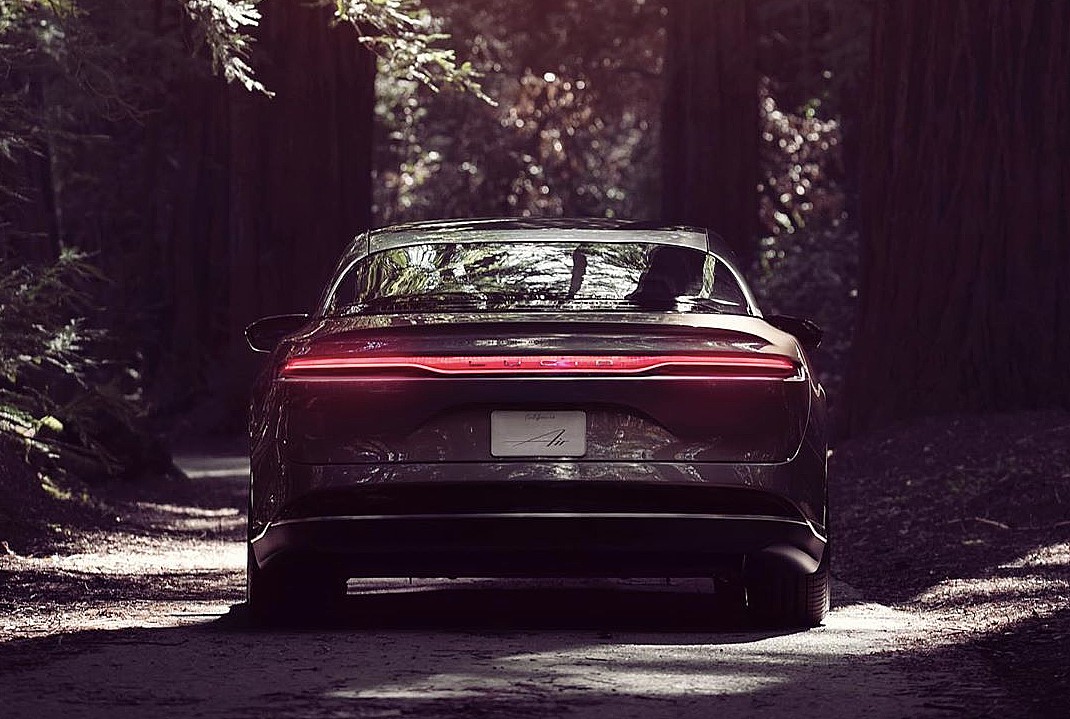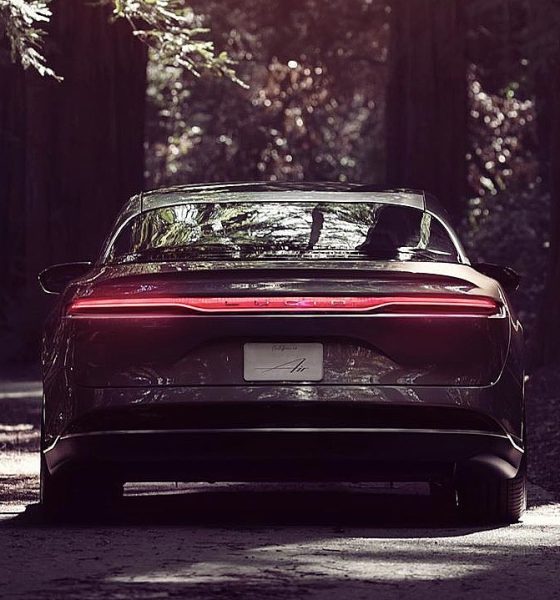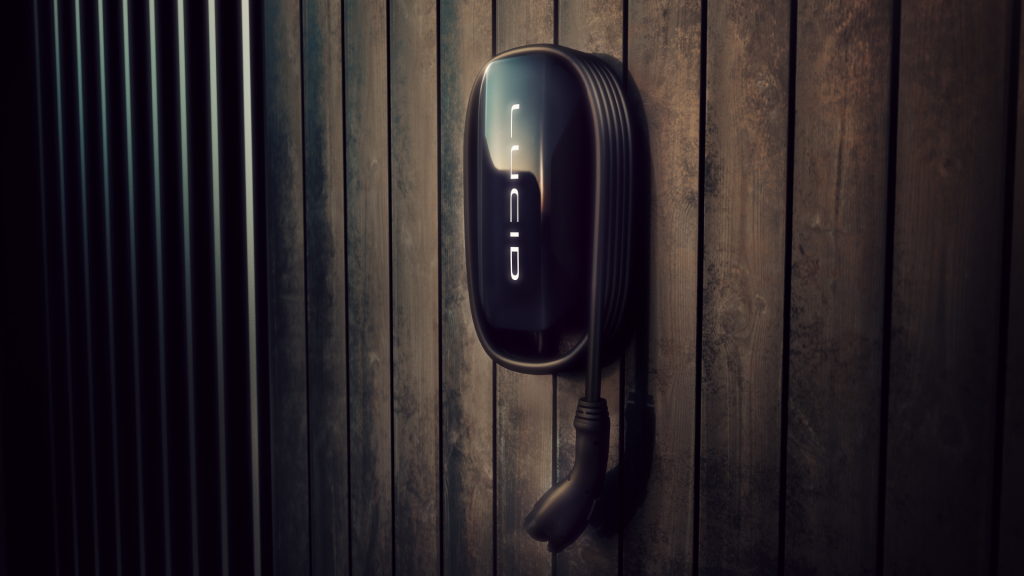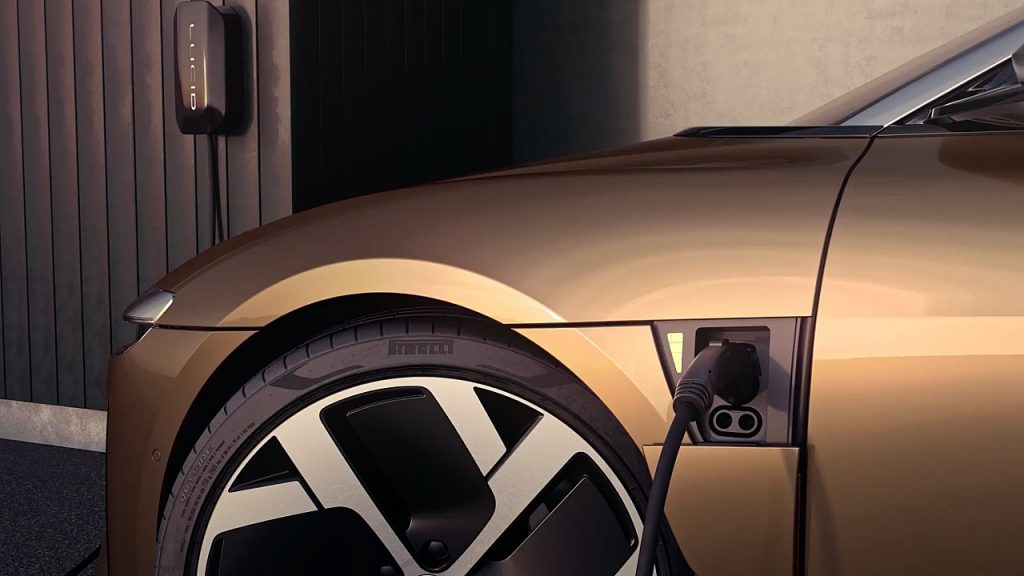

News
Lucid Air to offer vehicle-to-grid and vehicle-to-vehicle charging features
A recent press release from electric car maker Lucid Motors has revealed that the company will be rolling out its flagship Air sedan with a rather interesting feature: V2X. According to the company, “V2X” refers to “vehicle-to-everything,” which means that the Lucid Air will have full bi-directional capabilities built-in, allowing the car to function in both vehicle-to-grid (V2G) and vehicle-to-vehicle (V2V) scenarios.
As noted by the company in a press release, the Lucid Air’s bi-directional home charging capabilities could provide a lot of value to owners of the luxury electric sedan. Thanks to bi-directional charging, Lucid Air owners could utilize their vehicles as an energy storage unit to power their homes, which is particularly useful during those occasional trips to off-grid areas. The company described these features as follows.
“Home charging is one of the key benefits of EV ownership. In addition to the standard Lucid Mobile Charging Cord that comes with every Lucid vehicle, Lucid has also developed the Lucid Connected Home Charging Station, one of the first AC charging stations with bi-directional charging ever offered. With bi-directional charging, owners can enjoy not just a more cost-effective charging method, but also use their Lucid Air as a temporary energy reserve to power their homes, including off-grid vacation properties,” the company noted.

The rollout of the bi-directional Lucid Connected Home Charging Station is made possible by the EV maker’s integrated partnership with Qmerit. Owners of the Air who are interested in taking advantage of their vehicles’ bi-directional charging capabilities would be required to complete a digital survey, which Qmerit will then use to manage the installation process using its network of licensed electricians. Pricing for the Connected Home Charging Station is yet to be announced.
The Lucid Air’s vehicle-to-vehicle capabilities were not discussed by the company much in its recent press release, but the practical applications of the function are notable. With such a feature in place, Lucid Air owners would be able to provide power from their vehicles’ batteries to other electric cars that are low on energy. Interestingly enough, Lucid has not stated if its V2V capabilities will be universally compatible with other EVs, or if it is designed to work only between two Air sedans.

Vehicle-to-vehicle charging, while not yet mainstream, appears to be gaining ground in some territories. Just last year, for example, Hyundai launched India’s first V2V charging service, which allows owners with cars low on battery to call for another EV to be sent to their location. Once there, the recently-arrived electric car would be used as a power source for charging the customer’s vehicle.
The use of electric vehicles in V2G and V2V settings seems poised to spread in the near future. Earlier this year, reports emerged suggesting that industry leader Tesla is exploring vehicle-to-grid solutions for its growing fleet of vehicles, with noted Tesla hacker @greentheonly remarking that the company’s vehicles already have logic that allows DC to flow out of the company’s battery packs.
Interestingly enough, V2G is something that was discussed by former CTO JB Straubel, who noted back in 2015 that once there are a million Teslas on the road, the fleet could have substantial controllable load capacity. The 1-million-milestone was reached last March, and with Lucid offering “V2X” features right off the bat, it appears that the race to offer vehicle-to-grid services has just become a lot more interesting.

News
Tesla Giga Berlin draws “red line” over IG Metall union’s 35-hour week demands
Factory manager André Thierig has drawn a “red line” against reducing Giga Berlin’s workweek to 35 hours, while highlighting that Tesla has actually increased its workers’ salaries more substantially than other carmakers in the country.

Tesla Giga Berlin has found itself in a new labor dispute in Germany, where union IG Metall is pushing for adoption of a collective agreement to boost wages and implement changes, such as a 35-hour workweek.
In a comment, Giga Berlin manager André Thierig drew a “red line” against reducing Giga Berlin’s workweek to 35 hours, while highlighting that Tesla has actually increased its workers’ salaries more substantially than other carmakers in the country.
Tesla factory manager’s “red line”
Tesla Germany is expected to hold a works council election in 2026, which André Thierig considers very important. As per the Giga Berlin plant manager, Giga Berlin’s plant expansion plans might be put on hold if the election favors the union. He also spoke against some of the changes that IG Metall is seeking to implement in the factory, like a 35-hour week, as noted in an rbb24 report.
“The discussion about a 35-hour week is a red line for me. We will not cross it,” Theirig said.
“(The election) will determine whether we can continue our successful path in the future in an independent, flexible, and unbureaucratic manner. Personally, I cannot imagine that the decision-makers in the USA will continue to push ahead with the factory expansion if the election results favor IG Metall.”
Giga Berlin’s wage increase
IG Metall district manager Jan Otto told the German news agency DPA that without a collective agreement, Tesla’s wages remain significantly below levels at other German car factories. He noted the company excuses this by referencing its lowest pay grade, but added: “The two lowest pay grades are not even used in car factories.”
In response, Tesla noted that it has raised the wages of Gigafactory Berlin’s workers more than their German competitors. Thierig noted that with a collective agreement, Giga Berlin’s workers would have seen a 2% wage increase this year. But thanks to Tesla not being unionized, Gigafactory Berlin workers were able to receive a 4% increase, as noted in a CarUp report.
“There was a wage increase of 2% this year in the current collective agreement. Because we are in a different economic situation than the industry as a whole, we were able to double the wages – by 4%. Since production started, this corresponds to a wage increase of more than 25% in less than four years,” Thierig stated.
News
Tesla is seeing a lot of momentum from young Koreans in their 20s-30s: report
From January to November, young buyers purchased over 21,000 Teslas, putting it far ahead of fellow imported rivals like BMW and Mercedes-Benz.

Tesla has captured the hearts of South Korea’s 20s-30s demographic, emerging as the group’s top-selling imported car brand in 2025. From January to November, young buyers purchased over 21,000 Teslas, putting it far ahead of fellow imported rivals like BMW and Mercedes-Benz.
Industry experts cited by The Economist attributed this “Tesla frenzy” to fandom culture, where buyers prioritize the brand over traditional car attributes, similar to snapping up the latest iPhone.
Model Y dominates among young buyers
Data from the Korea Imported Automobile Association showed that Tesla sold 21,757 vehicles to the 20s-30s demographic through November, compared to BMW’s 13,666 and Mercedes-Benz’s 6,983. The Model Y led the list overwhelmingly, with variants like the standard and Long Range models topping purchases for both young men and women.
Young men bought around 16,000 Teslas, mostly Model Y (over 15,000 units), followed by Model 3. Young women followed a similar pattern, favoring Model Y (3,888 units) and Model 3 (1,083 units). The Cybertruck saw minimal sales in this group.
The Model Y’s appeal lies in its family-friendly SUV design, 400-500 km range, quick acceleration, and spacious cargo, which is ideal for commuting and leisure. The Model 3, on the other hand, serves as an accessible entry point with lower pricing, which is valuable considering the country’s EV subsidies.
The Tesla boom
Experts described Tesla’s popularity as “fandom culture,” where young buyers embrace the brand despite criticisms from skeptics. Professor Lee Ho-geun called Tesla a “typical early adopter brand,” comparing purchases to iPhones.
Professor Kim Pil-soo noted that young people view Tesla more as a gadget than a car, and they are likely drawn by marketing, subsidies, and perceived value. They also tend to overlook news of numerous recalls, which are mostly over-the-air software updates, and controversies tied to the company.
Tesla’s position as Korea’s top import for 2025 seems secured. As noted by the publication, Tesla’s December sales figures have not been reported yet, but market analysts have suggested that Tesla has all but secured the top spot among the country’s imported cars this year.
News
Tesla FSD fleet is nearing 7 billion total miles, including 2.5 billion city miles
As can be seen on Tesla’s official FSD webpage, vehicles equipped with the system have now navigated over 6.99 billion miles.

Tesla’s Full Self-Driving (Supervised) fleet is closing in on almost 7 billion total miles driven, as per data posted by the company on its official FSD webpage.
These figures hint at the massive scale of data fueling Tesla’s rapid FSD improvements, which have been quite notable as of late.
FSD mileage milestones
As can be seen on Tesla’s official FSD webpage, vehicles equipped with the system have now navigated over 6.99 billion miles. Tesla owner and avid FSD tester Whole Mars Catalog also shared a screenshot indicating that from the nearly 7 billion miles traveled by the FSD fleet, more than 2.5 billion miles were driven inside cities.
City miles are particularly valuable for complex urban scenarios like unprotected turns, pedestrian interactions, and traffic lights. This is also the difference-maker for FSD, as only complex solutions, such as Waymo’s self-driving taxis, operate similarly on inner-city streets. And even then, incidents such as the San Francisco blackouts have proven challenging for sensor-rich vehicles like Waymos.
Tesla’s data edge
Tesla has a number of advantages in the autonomous vehicle sector, one of which is the size of its fleet and the number of vehicles training FSD on real-world roads. Tesla’s nearly 7 billion FSD miles then allow the company to roll out updates that make its vehicles behave like they are being driven by experienced drivers, even if they are operating on their own.
So notable are Tesla’s improvements to FSD that NVIDIA Director of Robotics Jim Fan, after experiencing FSD v14, noted that the system is the first AI that passes what he described as a “Physical Turing Test.”
“Despite knowing exactly how robot learning works, I still find it magical watching the steering wheel turn by itself. First it feels surreal, next it becomes routine. Then, like the smartphone, taking it away actively hurts. This is how humanity gets rewired and glued to god-like technologies,” Fan wrote in a post on X.








